|
|
|
Sort Order |
|
|
|
Items / Page
|
|
|
|
|
|
|
| Srl | Item |
| 1 |
ID:
173394
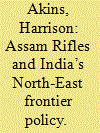

|
|
|
|
|
| Summary/Abstract |
The Assam Rifles, the oldest paramilitary group in India, was formed as a defensive force to protect tea estates from tribal raiding. Following independence, the Indian government reversed British policy in the North-East frontier to extend administrative control over tribal areas that were largely neglected under colonial rule. In aid of this policy change, the government shifted the role of the Assam Rifles to an offensive counterinsurgency force. Based on primary sources, this analysis helps to demonstrate how post-colonial states co-opt colonial institutions to reflect new policies and the use of coercive force by paramilitary groups in the state-making process.
|
|
|
|
|
|
|
|
|
|
|
|
|
|
|
|
| 2 |
ID:
169232
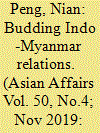

|
|
|
|
|
| Summary/Abstract |
There is a big gap on the study of Indo-Myanmar relations between India and China, in which the Indian experts are mainly concerned about the serious consequences of the China factor, while few Chinese scholars focus on Indo-Myanmar relations. This article, therefore, looks into the post-Cold War Indo-Myanmar relations from a Chinese perspective, so as to fill the research gap. It argues that India's influence upon Sino-Myanmar relations is actually marginal, though it has established a budding relationship with Myanmar through deepening political engagement, naval cooperation and physical connectivity with the country. The main reason is that India lacks full capability to develop the bilateral relations with Myanmar and thus compete fully with China. Additionally, the suspicion and resistance from the Burmese elite and local communities constitutes another major obstacle to the further engagement between India and Myanmar. Naypyidaw, notwithstanding its efforts to advance Indo-Myanmar relations, would prefer to gain benefits from both China and India.
|
|
|
|
|
|
|
|
|
|
|
|
|
|
|
|
| 3 |
ID:
164657
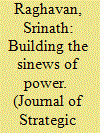

|
|
|
|
|
| Summary/Abstract |
This article analyses the military transformations that India underwent during the Second World War. It focuses on the institutional dimension of these changes and considers the longer-term changes wrought by the war in the composition of the army, the logistical and support infrastructure and the emergence of an indigenous military industrial base. Taken together, the article argues, these changes positioned India as a potential regional military power that was qualitatively different from the interwar period.
|
|
|
|
|
|
|
|
|
|
|
|
|
|
|
|
| 4 |
ID:
185781


|
|
|
|
|
| Summary/Abstract |
India and China share a complex bilateral relationship, consisting of military confrontations, diplomatic dialogues, and intense economic activities, concurrent with multilateral engagements. Their growth prospects and future visions set them on a path of intense competition. Also, China’s consistent growth to become a major player in the global arena poses many strategic challenges to India’s growth story.
The foremost challenge is that China poses a direct military threat to India, due to its rapidly modernising military forces, as well as the
bloody history of India-China territorial disputes. Second, China’s burgeoning economic muscle affords it the luxury of shaping world
opinion in its favour and to India’s detriment. This factor is compounded by China’s influence on international bodies like the UN and financial institutions like the Asian Infrastructure Investment Bank (AIIB), which may impinge on India’s national interests. Coupled with this is the consistently expanding Chinese influence in South Asia, directly challenging India’s dominant position in the region.
This commentary examines the challenges that India faces from China and further evaluates possible strategic options for India.
|
|
|
|
|
|
|
|
|
|
|
|
|
|
|
|
| 5 |
ID:
183438
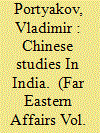

|
|
|
|
|
| Summary/Abstract |
This article considers the main trends and features of Chinese studies in India for the first time in Russia's scientific literature. The author provides reasons for the high level of activity among Indian Sinologists, describes the leading centers of Chinese studies in India, and analyzes the main forms of such studies. They include regular weekly seminars, lectures by foreign Sinologists, annual nationwide conferences, and special forums on China supported by the K. Adenauer Foundation. This article considers the topics of analyses and occasional reports published in the journal China Report and describes the most important Indian monographs on China published in recent years. The author analyzes works by Srikanth Kondapalli, a leading Indian Sinologist, as a concrete example, along with his approach to Indian-Chinese relations. This article shows the meager attention Indian researchers give to Russian-Chinese relations.
|
|
|
|
|
|
|
|
|
|
|
|
|
|
|
|
| 6 |
ID:
173328
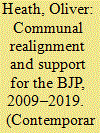

|
|
|
|
|
| Summary/Abstract |
To what extent has the BJP managed to capture the rural vote? And how does the party’s level of support relate to poverty and literacy? Is the Hindu-Muslim divide becoming more pronounced – or has it faded as the party seeks to broaden its appeal? Using constituency level data linked to census data, this article examines support for the BJP and patterns of social realignment at the constituency level from 2009 to 2019. In particular, I examine the impact of social cleavages related to the level of urbanisation, poverty, and literacy within a constituency, as well as its religious and caste profile. Using OLS regression with state-level fixed effects I present a detailed analysis of the social profile of places where the BJP has prospered over the last ten years and the major socio-geographical fault lines that run through the country. The results show that over the last three election cycles support for the BJP has become increasingly polarised along communal lines.
|
|
|
|
|
|
|
|
|
|
|
|
|
|
|
|
| 7 |
ID:
158679


|
|
|
|
|
| Summary/Abstract |
The literature on the India–Pakistan nuclear conundrum has neglected the impact of the international normative environment on India and Pakistan’s nuclear behavior. This article fills that gap, by looking at the impact of the nuclear taboo on Indo-Pakistani strategic interactions during the 1999 Kargil war and the 2002 border standoff. The nuclear taboo, rather than nuclear deterrence, explains the non-use of nuclear weapons. During both crises the nuclear taboo entered the decision-making process instrumentally, in the form of perceived reputational “costs.” The Indian and Pakistani emerging nuclear doctrines endanger a fragile nuclear taboo that would be strengthened by a bilateral non-first use accord. Whether India and Pakistan can move from an instrumental to a substantive acceptance of the nuclear taboo will depend on whether the United States and the other nuclear weapon states, included in the Nonproliferation Treaty, play the role of norm entrepreneurs and strengthen the nuclear taboo at the global level.
|
|
|
|
|
|
|
|
|
|
|
|
|
|
|
|
| 8 |
ID:
179550


|
|
|
|
|
| Summary/Abstract |
The Indian government has presented itself as a champion of gender mainstreaming in UN peacekeeping. At the same time, the domestic security sector in India continues to create a gender-segregated environment and experiences of uniformed women in the field show remaining barriers for gender equity. Given this contradiction, the article examines the ambivalence inherent to Indian gender mainstreaming of peacekeeping units. We argue that transnational norms, such as gender mainstreaming, are embedded in larger norm bundles, and we combine the literature of norm localization and norm contestation in our conceptual framework to illustrate how India localizes parts of the gender mainstreaming norm bundle whilst contesting others. We find that India’s localization of the gender mainstreaming norm has meant to pursue an asymmetric gender-parity approach between different branches of the Indian security forces and that it has fomented a division of labour within the police corps. Moreover, we illustrate how India contests the idea of placing women in security-sensitive areas, in combat roles, and gender-integrated police units.
|
|
|
|
|
|
|
|
|
|
|
|
|
|
|
|
| 9 |
ID:
185777


|
|
|
|
|
| Summary/Abstract |
The physical map of the Indian subcontinent depicts an integrated landmass, bounded by the Pamirs/ Hindukush to the North West and the Himalayas to the North, with the Patkai Range, Naga, and Chin Hills forming a natural border between India’s North-Eastern states and Myanmar. The ends of the Indian Peninsula are bounded by the seas in three directions. This article attempts to review important aspects of the continuously evolving India-Bangladesh relationship—as Bangladesh, today with the second largest GDP in South Asia, journeys through its fifty-first year as an independent nation.
|
|
|
|
|
|
|
|
|
|
|
|
|
|
|
|
| 10 |
ID:
189560
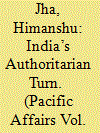

|
|
|
| 11 |
ID:
193637


|
|
|
|
|
| Summary/Abstract |
This paper explains and corroborates the mechanism by which civic and political spaces opposed to Hindu nationalism were attacked, especially after the arrival of the right-wing Hindu nationalist Bharatiya Janata Party (BJP) government in 2014. Three mechanisms are discerned for replacing pluralistic values with Hindu majoritarian ones. Sometimes institutions are just allowed to drift by interpreting old rules in new ways. For example, no formal rules for media control have changed but the government’s control over media has increased substantially. At other times, incremental legal and policy changes are executed to make the change explicit, often building on a new moral purpose. To give another example, the FCRA (2010) was amended and weaponized against NGOs in a layered way in 2020. Finally, when political opposition is weak, institutions that have provided guarantees for protecting diversity have simply been displaced by new and radically different ones. This was the case with abrogating Article 370, which converted the special status of the sub-national state of Jammu and Kashmir to the status of two federally administered union territories—Jammu and Kashmir and Ladakh. These mechanisms place India in a competitive authoritarian frame, where electoral majorities are deployed to systematically attack the political opposition, thereby making it more difficult for it to rise. Despite these propensities, opposition parties have won elections in some of India’s sub-national states. The challenges facing the world’s most populous democracy are significant, even though competitive elements co-exist. These elements in a competitive authoritarian regime, however, are under severe stress. India’s democratic credentials can be revived only if the competitive elements of India’s democracy stand united against ethno-nationalist Hindu majoritarianism.
|
|
|
|
|
|
|
|
|
|
|
|
|
|
|
|
| 12 |
ID:
135490
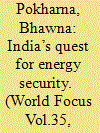

|
|
|
|
|
| Summary/Abstract |
Energy security has become central point of national security and foreign policy of India. Energy is the key element on which the economic growth of any country depends. Energy security refers to adequate supply of energy at reasonable cost which is ensured by guaranteeing three factors – availability, accessibility and affordability of energy resources. As India is projected to rely more on imported energy resources in future it has become cardinal issue of the foreign policy.
|
|
|
|
|
|
|
|
|
|
|
|
|
|
|
|
| 13 |
ID:
173299
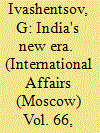

|
|
|
|
|
| Summary/Abstract |
INDIA is invariably mentioned among new major international actors. This is logical. Populated by 1.38 billion people, India is the world's second-largest country in terms of population. Its economy grew by a factor of 3.3 between 2000 and 2017 and, with its gross domestic product accounting for 7.4% of global GDP in terms of purchasing power parity, became the world's third-largest economy in 2017 after the economies of the United States and China. India's armed forces are the world's fourth-most powerful military after those of the United States, Russia and China. India possesses nuclear weapons and runs a space program comparable to those of the European Union, China and Japan. India holds a key geostrategic position along with increasingly powerful China, the oil- and natural gas-producing Middle East, and Africa with its growing economies. India also controls key shipping routes in the Indian Ocean.
|
|
|
|
|
|
|
|
|
|
|
|
|
|
|
|
| 14 |
ID:
193369


|
|
|
|
|
| Summary/Abstract |
It has been along held view that the west is the mother of democracy and all other modern values. This view of even promoted to justify the unethical and illegal colonial rule of centuries. Now India has come to claim that India not the West is the mother of democracy. India’s claim is more sustainable when we adopt a broader meaning of democracy. Democracy is not a form of government, but a way of life.
|
|
|
|
|
|
|
|
|
|
|
|
|
|
|
|
| 15 |
ID:
164659
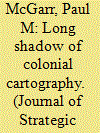

|
|
|
|
|
| Summary/Abstract |
This article examines British responses to the Sino-Indian border war of 1962. It illustrates how, in the years leading up to the war, Britain’s colonial legacy in the Indian subcontinent saw it drawn reluctantly into a territorial dispute between Asia’s two largest and most powerful nations. It analyses disagreements in Whitehall between the Foreign Office and Commonwealth Relations Office over the relative strength of India and China’s border claims, and assesses how these debates reshaped British regional policy. It argues that the border war was instrumental in transforming Britain’s post-colonial relationship with South Asia. Continuing to filter relations with India through an imperial prism proved unsatisfactory, what followed was a more pragmatic Indo-British association.
|
|
|
|
|
|
|
|
|
|
|
|
|
|
|
|
| 16 |
ID:
185262
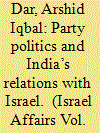

|
|
|
|
|
| Summary/Abstract |
Indian–Israeli relations have been experiencing a ‘historic moment’ since the advent of BJP as a dominant political party in India. Owing to its open embrace of Israel, the Modi-led BJP has become the most pro-Israel government in Indian history. However, contrary to the common attribution of this momentous shift to the ‘Modi factor’, New Delhi’s relations with Israel have been shaped – and continue to be determined – by the ideologies and party positions of the country’s two largest political parties – BJP and Congress.
|
|
|
|
|
|
|
|
|
|
|
|
|
|
|
|
| 17 |
ID:
179937


|
|
|
| 18 |
ID:
181700
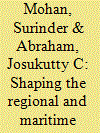

|
|
|
|
|
| Summary/Abstract |
In this paper, we argue that China is seeking to establish a balance of power favourable to its interests in South Asia and the adjoining waters to curtail India’s rise. Military balancing, economic engagement, and the new multi-regional connectivity project – the “Belt and Road Initiative” – are the key components of China’s policy against India. By roping in the South Asian and the Indian Ocean states, China has effectively deployed the “string of pearls” strategy with an express purpose to box-in India within the region so that it cannot challenge China’s primacy in Asia and beyond. To neutralise Beijing’s assertive activities, New Delhi has evolved its Asia policy with a clear motive to enhance its ties with the key Indo-Pacific states – the US, Japan, Australia, and the Southeast Asian countries – so that it could develop counter-leverages against China and simultaneously manage its rise as a major Indo-Pacific power. Given that both India and China are vying for similar power position in the same region, it is highly likely that their clashing interests might intensify their power competition in the near future.
|
|
|
|
|
|
|
|
|
|
|
|
|
|
|
|
| 19 |
ID:
164656


|
|
|
|
|
| Summary/Abstract |
This Special Issue looks at the importance of institutions and the role played by international actors in crucial episodes of India’s strategic history. The contributions trace India’s tryst with war and peace from immediately before the foundation of the contemporary Indian state to the last military conflict between India and Pakistan in 1999. The focus of the articles is as much on India as it is on Pakistan and China, its opponents in war. The articles offer a fresh take on the creation of India as a regional military power, and her approach to War and Peace in the post-independence period.
|
|
|
|
|
|
|
|
|
|
|
|
|
|
|
|
|
|
|
|
|